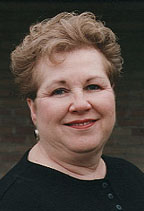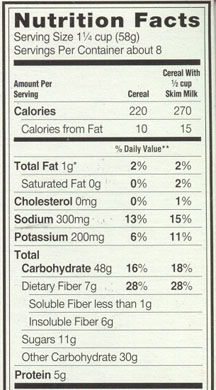 Prepared by:
Prepared by:
Donna Montgomery, M.S.
Page 2 of 4
Remember that a serving and a
helping are not the same thing. If you eat more or less than
the serving size on the label, you'll need to adjust the amounts
of nutrients accordingly.
A neat trick you can
use to see if food is a good source of a nutrient is to remember
the 5 and 20 rule. If a food has 5% or less of a nutrient, it
is considered low in that nutrient. If it has 20% or more, it's
considered high.
|
|
Click here for the printable (Word) version of the lesson
Nutrition
Facts
Label
 Let's take a look at a Nutrition
Facts label. We'll start at the top and work our way down.
You'll want to follow along on a food package you have in hand
or on the label included here. Let's take a look at a Nutrition
Facts label. We'll start at the top and work our way down.
You'll want to follow along on a food package you have in hand
or on the label included here.
Serving size is the first thing you will see on the top
of the label. Calorie and nutrient content are given per serving.
Serving sizes have been standardized for most foods. They reflect
the amounts people actually eat. Standardized servings make it
easier to make comparisons. Servings are given in common household
measures as well as metric measure. For example, the serving
size here is one cup or 228 grams.
Remember that a serving and a helping are not the same thing.
If you eat more or less than the serving size on the label, you'll
need to adjust the amounts of nutrients accordingly. Just for
fun, check the serving size on your box of cereal. Next time
you serve yourself a bowl, measure out one serving. Is this more
or less than you normally eat?
Next is servings per container . This tells you how many
servings you can expect to get. In this package there are two
one-cup servings. The next part of the label tells you how many
calories and nutrients are in each serving of the food.
Calories per serving is first. In this food there are
260 calories in each one-cup serving. Remember, if you eat two
servings, you have to double the calories and all the nutrients.
Of those 260 calories, 120 calories are from fat. This is shown
to help you meet the dietary guidelines that recommend people
get no more than 30% of their calories from fat. This food has
120 of the 260 calories from fat, or 46% calories from fat.
Nutrients listed on the label are those most important
to the health of today's consumers. Some nutrients we should
try to eat less of such as fat, saturated fat, cholesterol and
sodium. Some nutrients we need more of such as fiber, vitamin
A, vitamin C, calcium and iron. The label tells you how much
of each of these nutrients is in a serving of the food. It's
hard to know if that amount is a lot or a little.
To make your job easier, the Nutrition Facts label includes %
Daily Value. The % Daily Value shows you how a food fits
into your overall diet. For example, if you see a food contains
200 milligrams of cholesterol and 200 milligrams of sodium, would
you know it is high in cholesterol and low in sodium? The % Daily
Value is the clue. It tells you that it has 66% of your daily
value for cholesterol and 8% of your daily value for sodium.
Daily Values are based on a daily diet of 2,000 calories. Cholesterol,
sodium, vitamin A, vitamin C, calcium and iron do not change
on a higher or lower caloric intake.
A neat trick you can use is to remember the 5 and 20 rule.
If a food has 5% or less of a nutrient, it is considered low
in that nutrient. If it has 20% or more, it's considered high.
To learn more about the food label, click on the locator address:
http://phys.com. Under the nutrition
column, click on Eating Right. Scroll down and click on
Label Lessons. Begin at the top of the label and click
on each statement to the right and left of the label. Read what
each means. As you do the assignment, click on Calculate Your
Calorie Requirement when it comes up. Do that exercise as
well. After you learn what each thing on the label means, go
to the bottom of the label and click on Label Lessons Main
Page to return to food label. When you have finished, scroll
up and look on the right side of the screen. Click on Find
Out how to Decode the Marketing Claims on the front of the
box. Click on each descriptive term and learn what it means.
   [ LESSONS || SITE
MAP || LOCAL AGENTS || RESOURCES || PEOPLE ]
[ LESSONS || SITE
MAP || LOCAL AGENTS || RESOURCES || PEOPLE ]
 Issued in furtherance of Cooperative Extension
work, Acts of Congress of May 8 and June 30, 1914, in cooperation
with the United States Department of Agriculture. The Louisiana
Cooperative Extension Service provides equal opportunities in
programs and employment. Information and Graphics on this site
are copyright protected by LSU Agricultural Center's Louisiana Cooperative Extension Services.
For more information
on the EFNEP program, contact EFNEPMail@agcenter.lsu.edu. Issued in furtherance of Cooperative Extension
work, Acts of Congress of May 8 and June 30, 1914, in cooperation
with the United States Department of Agriculture. The Louisiana
Cooperative Extension Service provides equal opportunities in
programs and employment. Information and Graphics on this site
are copyright protected by LSU Agricultural Center's Louisiana Cooperative Extension Services.
For more information
on the EFNEP program, contact EFNEPMail@agcenter.lsu.edu.
|